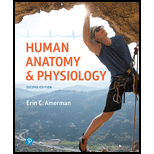
To review:
Match the following terms with thecorrect definitions.
Endergonic reaction
Potential energy
Electrical energy
Anabolic
Oxidation-reduction reaction
Chemical energy
Catabolic reaction
Kinetic energy
The definitions are:
Energy in motion.
Energy stored in
The reaction that consumes energy.
A decomposition reaction.
The energy of moving charged particle.
Stored energy.
Synthesis reaction.
A reaction where electrons are transferred between the reactants.
Introduction:
A
Want to see the full answer?
Check out a sample textbook solution
Chapter 2 Solutions
Pearson eText Human Anatomy & Physiology -- Instant Access (Pearson+)
- Define the following terms: a. catalytic dyad b. transition state theory c. hydroxide ion catalysis d. reaction intermediate e. proximity and orientation effectsarrow_forwardWhat statements concerning free energy change are true or false? a. Free energy change is a measure of the rate of a reaction. b. Free energy change is a measure of the maximum amount of work available from a reaction. c. Free energy change is a constant for a reaction under any conditions. d. Free energy is related to the equilibrium constant for a specific reaction. e. Free energy change is equal to zero at equilibriumarrow_forwardWhich of the following increases the rate of a reaction? a. cold temperatures b. solid reactants c. increased reactant concentration d. absence of a catalystarrow_forward
- Identify the statements that are TRUE regarding Catabolic reactions. SELECT ALL THAT APPLY A. These reactions may also be called decomposition reactions B. These reactions create smaller products from larger reactants C. These reactions involve the formation of new bonds. D. These reactions typically release energy.arrow_forwardWhich of the followingdescribe superior properties of enzymes (biological catalysts) over traditional chemical catalysts? a. They are mostly and generally operative under mild temperature, pressure, and pH conditions b. They are regulated only by substrate concentration c. They do not effect the reaction equilibrium, but lower the reaction's activation energy d. They are recycled at the end of the reaction Choose all that applyarrow_forwardWhich of the following is true for all exergonic reactions? Group of answer choices A. The reactions are nonspontaneous B. A net input of energy from the surroundings is required for the reactions to proceed C. Some reactants will be converted to products D. The products have more total energy than the reactants E. The reaction proceeds with a net release of free energyarrow_forward
- One major difference between inorganic catalysts and organic catalysts is: A. Inorganic catalysts may not be compatible with biological parameters B. Organic catalysts are consumed during the chemical reaction C. Organic catalysts influence the activation energy of a reaction D. Inorganic catalysts decrease the probability a reaction will occurarrow_forwardWhich statements concerning free energy change are true?a. Free energy change is a measure of the rate of a reaction.b. Free energy change is a measure of the maximum amountof work available from a reaction.c. Free energy change is a constant for a reaction under anyconditions.d. Free energy change is related to the equilibrium constantfor a specific reaction.e. Free energy change is equal to zero at equilibrium.arrow_forwardIdentify the bisubstrate reaction type represented by the curve below. B 2B 1/A O Single Substrate Reaction O Random Single-Displacement Reaction O Ordered Single-Displacement Reaction O Ping-Pong Reaction A/Tarrow_forward
- A reducing chemical reaction: a. reduces the compound to a simpler form b. adds an electron to the substrate c. removes a hydrogen atom from the substrate d. is a catabolic reaction. With reason.arrow_forwardDiagrams like the one below are used to represent exothermic reactions. For instance, consider burning charcoal (which almost entirely pure element carbon). A=carbon and B=oxygen, when they react they form C=carbon dioxide. A little chemistry vocab: does substance C in the diagram represent a reactant or the product? Activation Energy A+B Reaction Progression Energyarrow_forwardFill in the blanks by writing the name of the definition: In a __________ reaction the transfer of electrons takes place a. Precipitation b. Decomposition c. redox d. displacementarrow_forward
 Human Anatomy & Physiology (11th Edition)BiologyISBN:9780134580999Author:Elaine N. Marieb, Katja N. HoehnPublisher:PEARSON
Human Anatomy & Physiology (11th Edition)BiologyISBN:9780134580999Author:Elaine N. Marieb, Katja N. HoehnPublisher:PEARSON Biology 2eBiologyISBN:9781947172517Author:Matthew Douglas, Jung Choi, Mary Ann ClarkPublisher:OpenStax
Biology 2eBiologyISBN:9781947172517Author:Matthew Douglas, Jung Choi, Mary Ann ClarkPublisher:OpenStax Anatomy & PhysiologyBiologyISBN:9781259398629Author:McKinley, Michael P., O'loughlin, Valerie Dean, Bidle, Theresa StouterPublisher:Mcgraw Hill Education,
Anatomy & PhysiologyBiologyISBN:9781259398629Author:McKinley, Michael P., O'loughlin, Valerie Dean, Bidle, Theresa StouterPublisher:Mcgraw Hill Education, Molecular Biology of the Cell (Sixth Edition)BiologyISBN:9780815344322Author:Bruce Alberts, Alexander D. Johnson, Julian Lewis, David Morgan, Martin Raff, Keith Roberts, Peter WalterPublisher:W. W. Norton & Company
Molecular Biology of the Cell (Sixth Edition)BiologyISBN:9780815344322Author:Bruce Alberts, Alexander D. Johnson, Julian Lewis, David Morgan, Martin Raff, Keith Roberts, Peter WalterPublisher:W. W. Norton & Company Laboratory Manual For Human Anatomy & PhysiologyBiologyISBN:9781260159363Author:Martin, Terry R., Prentice-craver, CynthiaPublisher:McGraw-Hill Publishing Co.
Laboratory Manual For Human Anatomy & PhysiologyBiologyISBN:9781260159363Author:Martin, Terry R., Prentice-craver, CynthiaPublisher:McGraw-Hill Publishing Co. Inquiry Into Life (16th Edition)BiologyISBN:9781260231700Author:Sylvia S. Mader, Michael WindelspechtPublisher:McGraw Hill Education
Inquiry Into Life (16th Edition)BiologyISBN:9781260231700Author:Sylvia S. Mader, Michael WindelspechtPublisher:McGraw Hill Education





